The Impact of Tourism on Wildlife and the Environment
VerifiedAdded on 2023/01/16
|7
|1552
|97
Essay
AI Summary
This essay explores the multifaceted impacts of tourism on wildlife, with a specific focus on the effects of climate change. It begins by defining climate change and its broad implications for ecosystems and biodiversity. The essay then delves into how wildlife tourism, a sector heavily reliant on natural resources, is particularly vulnerable to climate change. It discusses specific examples, such as the adverse effects of coral bleaching on the Great Barrier Reef and the decline in bird populations due to rising temperatures and shifting migration patterns. The essay highlights the interconnectedness of wildlife health, human activities, and habitats, emphasizing the negative consequences of tourism-related climate change. It also touches on the industry's contribution to global warming through energy-intensive practices and luxurious accommodations. The essay concludes by underscoring the urgent need to address tourism's environmental footprint to protect wildlife and preserve natural resources.
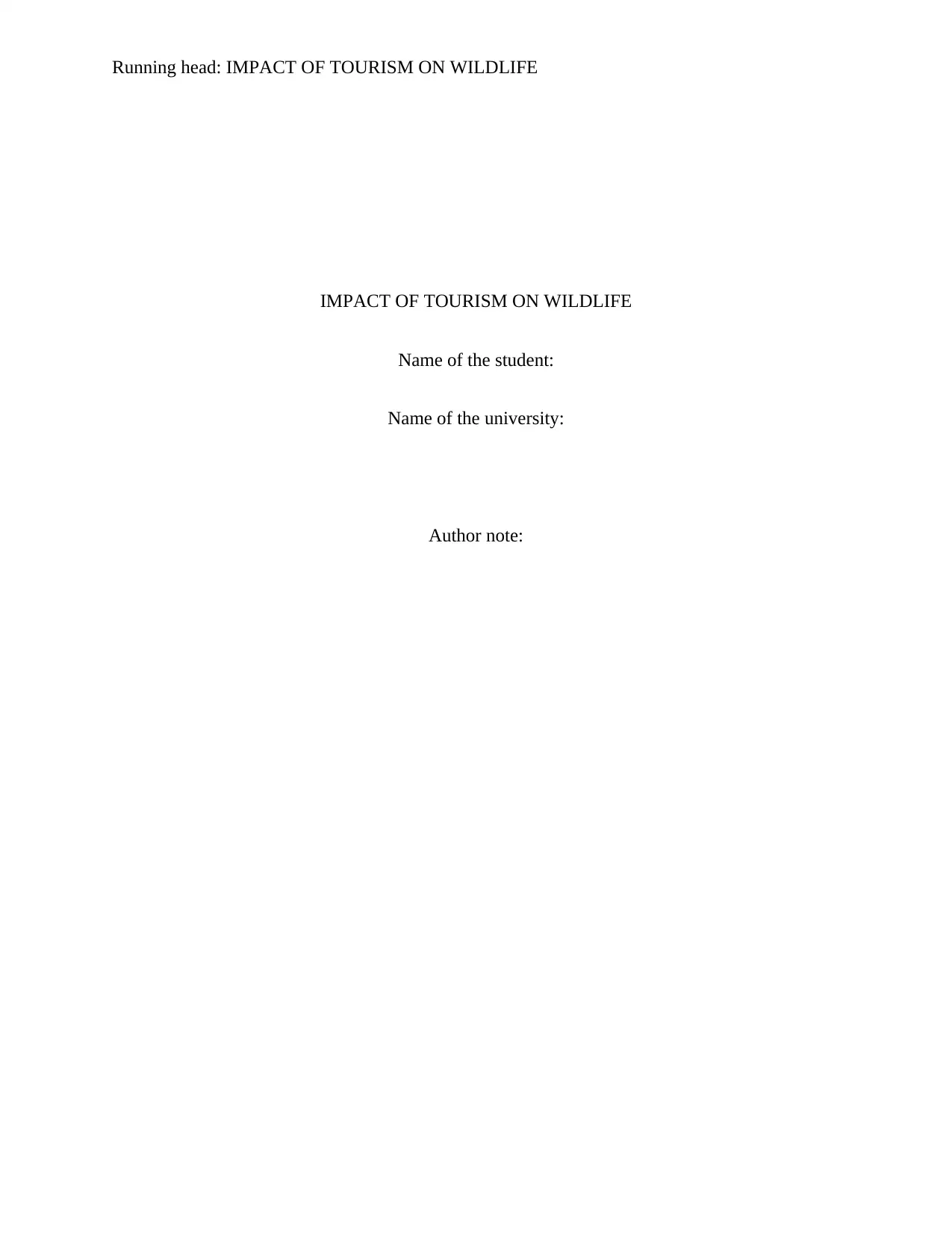
Running head: IMPACT OF TOURISM ON WILDLIFE
IMPACT OF TOURISM ON WILDLIFE
Name of the student:
Name of the university:
Author note:
IMPACT OF TOURISM ON WILDLIFE
Name of the student:
Name of the university:
Author note:
Paraphrase This Document
Need a fresh take? Get an instant paraphrase of this document with our AI Paraphraser
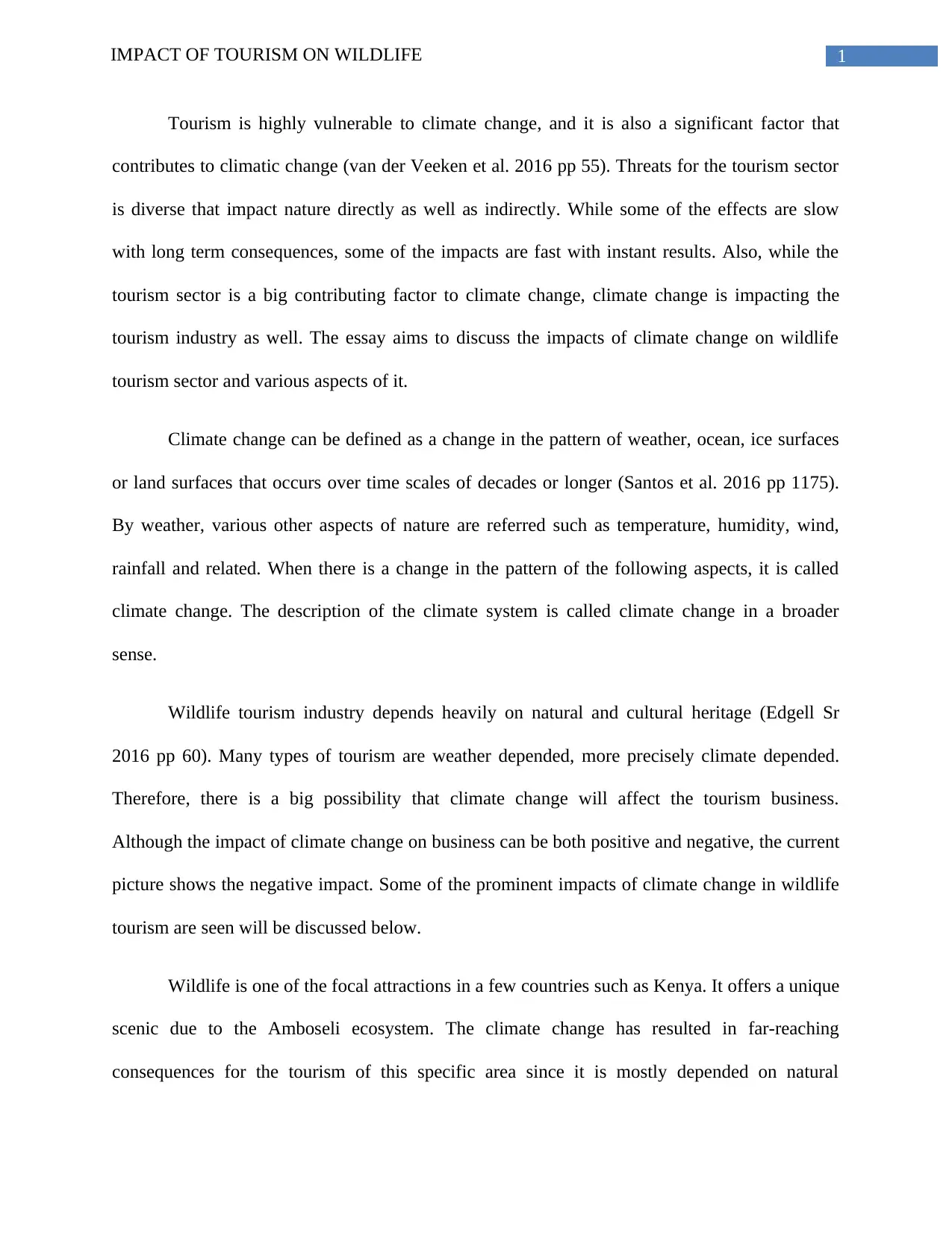
1IMPACT OF TOURISM ON WILDLIFE
Tourism is highly vulnerable to climate change, and it is also a significant factor that
contributes to climatic change (van der Veeken et al. 2016 pp 55). Threats for the tourism sector
is diverse that impact nature directly as well as indirectly. While some of the effects are slow
with long term consequences, some of the impacts are fast with instant results. Also, while the
tourism sector is a big contributing factor to climate change, climate change is impacting the
tourism industry as well. The essay aims to discuss the impacts of climate change on wildlife
tourism sector and various aspects of it.
Climate change can be defined as a change in the pattern of weather, ocean, ice surfaces
or land surfaces that occurs over time scales of decades or longer (Santos et al. 2016 pp 1175).
By weather, various other aspects of nature are referred such as temperature, humidity, wind,
rainfall and related. When there is a change in the pattern of the following aspects, it is called
climate change. The description of the climate system is called climate change in a broader
sense.
Wildlife tourism industry depends heavily on natural and cultural heritage (Edgell Sr
2016 pp 60). Many types of tourism are weather depended, more precisely climate depended.
Therefore, there is a big possibility that climate change will affect the tourism business.
Although the impact of climate change on business can be both positive and negative, the current
picture shows the negative impact. Some of the prominent impacts of climate change in wildlife
tourism are seen will be discussed below.
Wildlife is one of the focal attractions in a few countries such as Kenya. It offers a unique
scenic due to the Amboseli ecosystem. The climate change has resulted in far-reaching
consequences for the tourism of this specific area since it is mostly depended on natural
Tourism is highly vulnerable to climate change, and it is also a significant factor that
contributes to climatic change (van der Veeken et al. 2016 pp 55). Threats for the tourism sector
is diverse that impact nature directly as well as indirectly. While some of the effects are slow
with long term consequences, some of the impacts are fast with instant results. Also, while the
tourism sector is a big contributing factor to climate change, climate change is impacting the
tourism industry as well. The essay aims to discuss the impacts of climate change on wildlife
tourism sector and various aspects of it.
Climate change can be defined as a change in the pattern of weather, ocean, ice surfaces
or land surfaces that occurs over time scales of decades or longer (Santos et al. 2016 pp 1175).
By weather, various other aspects of nature are referred such as temperature, humidity, wind,
rainfall and related. When there is a change in the pattern of the following aspects, it is called
climate change. The description of the climate system is called climate change in a broader
sense.
Wildlife tourism industry depends heavily on natural and cultural heritage (Edgell Sr
2016 pp 60). Many types of tourism are weather depended, more precisely climate depended.
Therefore, there is a big possibility that climate change will affect the tourism business.
Although the impact of climate change on business can be both positive and negative, the current
picture shows the negative impact. Some of the prominent impacts of climate change in wildlife
tourism are seen will be discussed below.
Wildlife is one of the focal attractions in a few countries such as Kenya. It offers a unique
scenic due to the Amboseli ecosystem. The climate change has resulted in far-reaching
consequences for the tourism of this specific area since it is mostly depended on natural
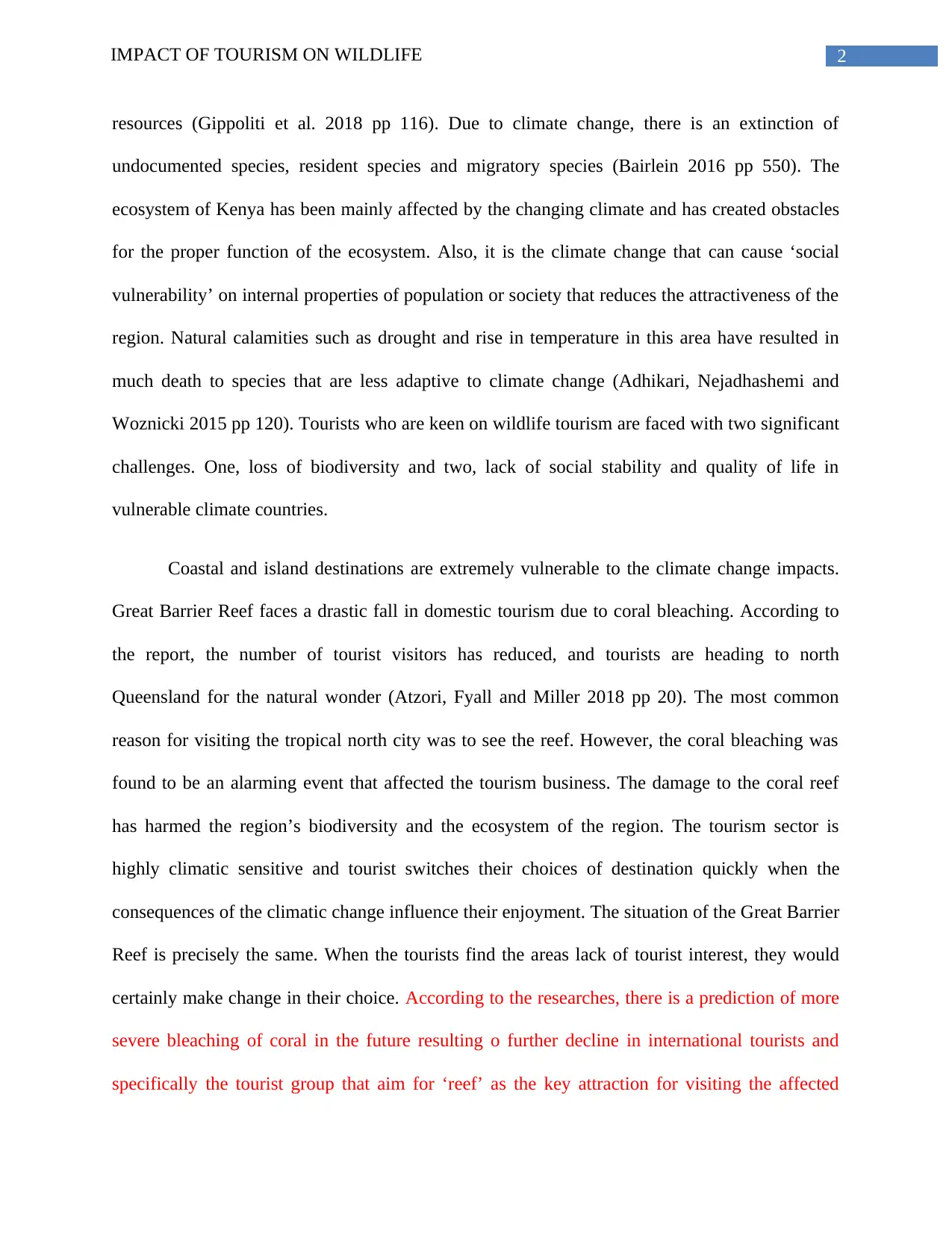
2IMPACT OF TOURISM ON WILDLIFE
resources (Gippoliti et al. 2018 pp 116). Due to climate change, there is an extinction of
undocumented species, resident species and migratory species (Bairlein 2016 pp 550). The
ecosystem of Kenya has been mainly affected by the changing climate and has created obstacles
for the proper function of the ecosystem. Also, it is the climate change that can cause ‘social
vulnerability’ on internal properties of population or society that reduces the attractiveness of the
region. Natural calamities such as drought and rise in temperature in this area have resulted in
much death to species that are less adaptive to climate change (Adhikari, Nejadhashemi and
Woznicki 2015 pp 120). Tourists who are keen on wildlife tourism are faced with two significant
challenges. One, loss of biodiversity and two, lack of social stability and quality of life in
vulnerable climate countries.
Coastal and island destinations are extremely vulnerable to the climate change impacts.
Great Barrier Reef faces a drastic fall in domestic tourism due to coral bleaching. According to
the report, the number of tourist visitors has reduced, and tourists are heading to north
Queensland for the natural wonder (Atzori, Fyall and Miller 2018 pp 20). The most common
reason for visiting the tropical north city was to see the reef. However, the coral bleaching was
found to be an alarming event that affected the tourism business. The damage to the coral reef
has harmed the region’s biodiversity and the ecosystem of the region. The tourism sector is
highly climatic sensitive and tourist switches their choices of destination quickly when the
consequences of the climatic change influence their enjoyment. The situation of the Great Barrier
Reef is precisely the same. When the tourists find the areas lack of tourist interest, they would
certainly make change in their choice. According to the researches, there is a prediction of more
severe bleaching of coral in the future resulting o further decline in international tourists and
specifically the tourist group that aim for ‘reef’ as the key attraction for visiting the affected
resources (Gippoliti et al. 2018 pp 116). Due to climate change, there is an extinction of
undocumented species, resident species and migratory species (Bairlein 2016 pp 550). The
ecosystem of Kenya has been mainly affected by the changing climate and has created obstacles
for the proper function of the ecosystem. Also, it is the climate change that can cause ‘social
vulnerability’ on internal properties of population or society that reduces the attractiveness of the
region. Natural calamities such as drought and rise in temperature in this area have resulted in
much death to species that are less adaptive to climate change (Adhikari, Nejadhashemi and
Woznicki 2015 pp 120). Tourists who are keen on wildlife tourism are faced with two significant
challenges. One, loss of biodiversity and two, lack of social stability and quality of life in
vulnerable climate countries.
Coastal and island destinations are extremely vulnerable to the climate change impacts.
Great Barrier Reef faces a drastic fall in domestic tourism due to coral bleaching. According to
the report, the number of tourist visitors has reduced, and tourists are heading to north
Queensland for the natural wonder (Atzori, Fyall and Miller 2018 pp 20). The most common
reason for visiting the tropical north city was to see the reef. However, the coral bleaching was
found to be an alarming event that affected the tourism business. The damage to the coral reef
has harmed the region’s biodiversity and the ecosystem of the region. The tourism sector is
highly climatic sensitive and tourist switches their choices of destination quickly when the
consequences of the climatic change influence their enjoyment. The situation of the Great Barrier
Reef is precisely the same. When the tourists find the areas lack of tourist interest, they would
certainly make change in their choice. According to the researches, there is a prediction of more
severe bleaching of coral in the future resulting o further decline in international tourists and
specifically the tourist group that aim for ‘reef’ as the key attraction for visiting the affected
⊘ This is a preview!⊘
Do you want full access?
Subscribe today to unlock all pages.

Trusted by 1+ million students worldwide
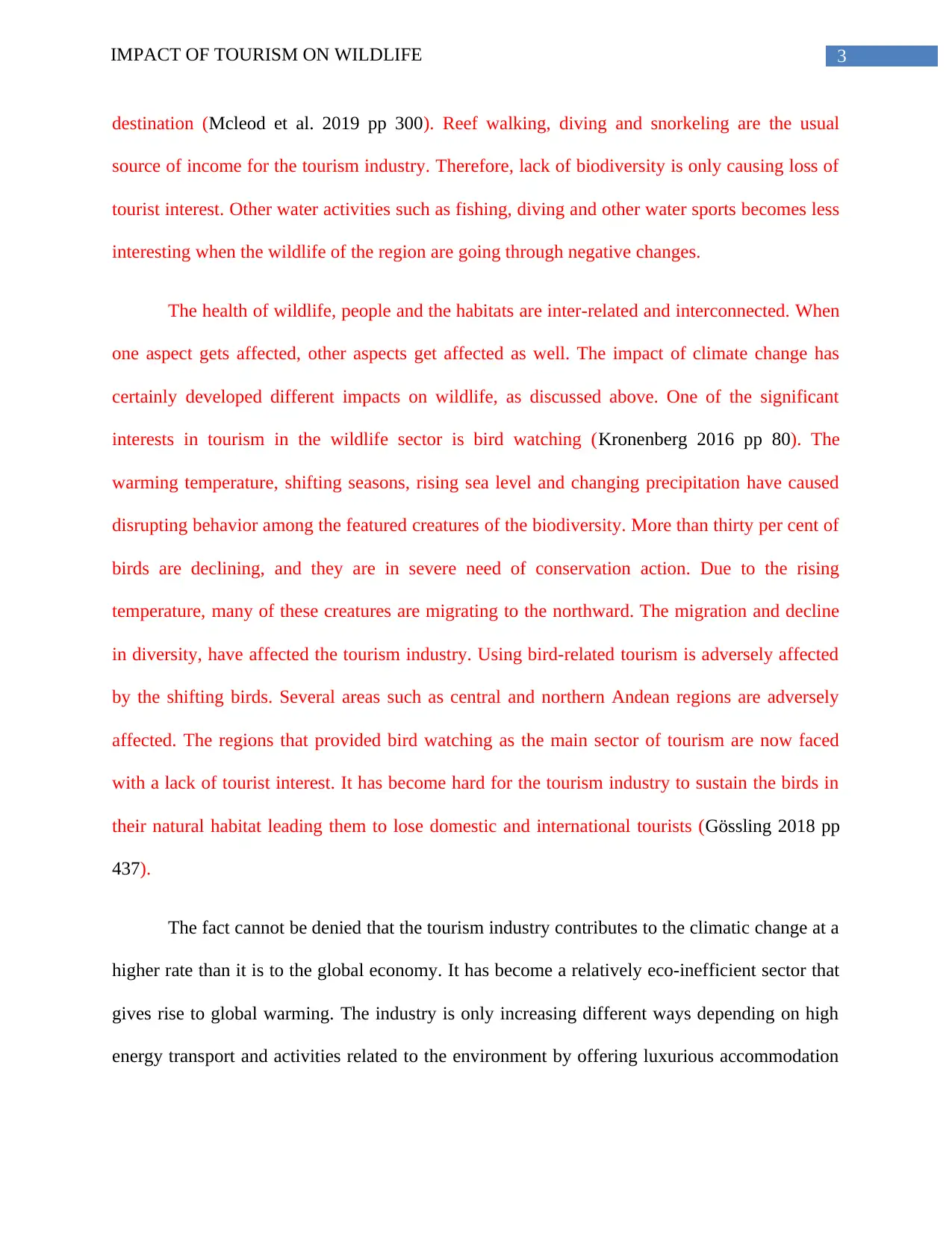
3IMPACT OF TOURISM ON WILDLIFE
destination (Mcleod et al. 2019 pp 300). Reef walking, diving and snorkeling are the usual
source of income for the tourism industry. Therefore, lack of biodiversity is only causing loss of
tourist interest. Other water activities such as fishing, diving and other water sports becomes less
interesting when the wildlife of the region are going through negative changes.
The health of wildlife, people and the habitats are inter-related and interconnected. When
one aspect gets affected, other aspects get affected as well. The impact of climate change has
certainly developed different impacts on wildlife, as discussed above. One of the significant
interests in tourism in the wildlife sector is bird watching (Kronenberg 2016 pp 80). The
warming temperature, shifting seasons, rising sea level and changing precipitation have caused
disrupting behavior among the featured creatures of the biodiversity. More than thirty per cent of
birds are declining, and they are in severe need of conservation action. Due to the rising
temperature, many of these creatures are migrating to the northward. The migration and decline
in diversity, have affected the tourism industry. Using bird-related tourism is adversely affected
by the shifting birds. Several areas such as central and northern Andean regions are adversely
affected. The regions that provided bird watching as the main sector of tourism are now faced
with a lack of tourist interest. It has become hard for the tourism industry to sustain the birds in
their natural habitat leading them to lose domestic and international tourists (Gössling 2018 pp
437).
The fact cannot be denied that the tourism industry contributes to the climatic change at a
higher rate than it is to the global economy. It has become a relatively eco-inefficient sector that
gives rise to global warming. The industry is only increasing different ways depending on high
energy transport and activities related to the environment by offering luxurious accommodation
destination (Mcleod et al. 2019 pp 300). Reef walking, diving and snorkeling are the usual
source of income for the tourism industry. Therefore, lack of biodiversity is only causing loss of
tourist interest. Other water activities such as fishing, diving and other water sports becomes less
interesting when the wildlife of the region are going through negative changes.
The health of wildlife, people and the habitats are inter-related and interconnected. When
one aspect gets affected, other aspects get affected as well. The impact of climate change has
certainly developed different impacts on wildlife, as discussed above. One of the significant
interests in tourism in the wildlife sector is bird watching (Kronenberg 2016 pp 80). The
warming temperature, shifting seasons, rising sea level and changing precipitation have caused
disrupting behavior among the featured creatures of the biodiversity. More than thirty per cent of
birds are declining, and they are in severe need of conservation action. Due to the rising
temperature, many of these creatures are migrating to the northward. The migration and decline
in diversity, have affected the tourism industry. Using bird-related tourism is adversely affected
by the shifting birds. Several areas such as central and northern Andean regions are adversely
affected. The regions that provided bird watching as the main sector of tourism are now faced
with a lack of tourist interest. It has become hard for the tourism industry to sustain the birds in
their natural habitat leading them to lose domestic and international tourists (Gössling 2018 pp
437).
The fact cannot be denied that the tourism industry contributes to the climatic change at a
higher rate than it is to the global economy. It has become a relatively eco-inefficient sector that
gives rise to global warming. The industry is only increasing different ways depending on high
energy transport and activities related to the environment by offering luxurious accommodation
Paraphrase This Document
Need a fresh take? Get an instant paraphrase of this document with our AI Paraphraser

4IMPACT OF TOURISM ON WILDLIFE
and experiences. For decades the industry has been impacting the environment until recently
when the climatic change impacts the tourism industry.
and experiences. For decades the industry has been impacting the environment until recently
when the climatic change impacts the tourism industry.
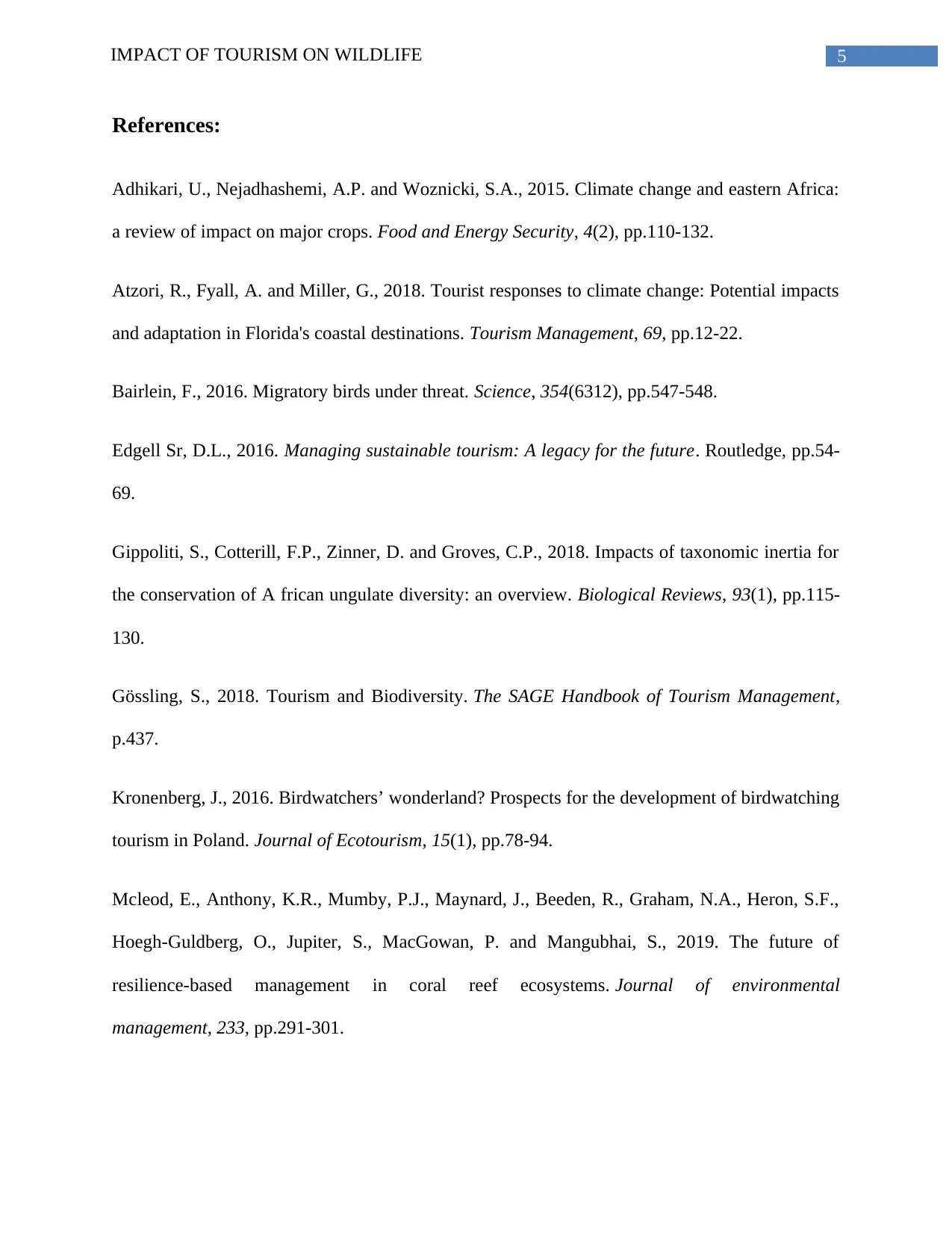
5IMPACT OF TOURISM ON WILDLIFE
References:
Adhikari, U., Nejadhashemi, A.P. and Woznicki, S.A., 2015. Climate change and eastern Africa:
a review of impact on major crops. Food and Energy Security, 4(2), pp.110-132.
Atzori, R., Fyall, A. and Miller, G., 2018. Tourist responses to climate change: Potential impacts
and adaptation in Florida's coastal destinations. Tourism Management, 69, pp.12-22.
Bairlein, F., 2016. Migratory birds under threat. Science, 354(6312), pp.547-548.
Edgell Sr, D.L., 2016. Managing sustainable tourism: A legacy for the future. Routledge, pp.54-
69.
Gippoliti, S., Cotterill, F.P., Zinner, D. and Groves, C.P., 2018. Impacts of taxonomic inertia for
the conservation of A frican ungulate diversity: an overview. Biological Reviews, 93(1), pp.115-
130.
Gössling, S., 2018. Tourism and Biodiversity. The SAGE Handbook of Tourism Management,
p.437.
Kronenberg, J., 2016. Birdwatchers’ wonderland? Prospects for the development of birdwatching
tourism in Poland. Journal of Ecotourism, 15(1), pp.78-94.
Mcleod, E., Anthony, K.R., Mumby, P.J., Maynard, J., Beeden, R., Graham, N.A., Heron, S.F.,
Hoegh-Guldberg, O., Jupiter, S., MacGowan, P. and Mangubhai, S., 2019. The future of
resilience-based management in coral reef ecosystems. Journal of environmental
management, 233, pp.291-301.
References:
Adhikari, U., Nejadhashemi, A.P. and Woznicki, S.A., 2015. Climate change and eastern Africa:
a review of impact on major crops. Food and Energy Security, 4(2), pp.110-132.
Atzori, R., Fyall, A. and Miller, G., 2018. Tourist responses to climate change: Potential impacts
and adaptation in Florida's coastal destinations. Tourism Management, 69, pp.12-22.
Bairlein, F., 2016. Migratory birds under threat. Science, 354(6312), pp.547-548.
Edgell Sr, D.L., 2016. Managing sustainable tourism: A legacy for the future. Routledge, pp.54-
69.
Gippoliti, S., Cotterill, F.P., Zinner, D. and Groves, C.P., 2018. Impacts of taxonomic inertia for
the conservation of A frican ungulate diversity: an overview. Biological Reviews, 93(1), pp.115-
130.
Gössling, S., 2018. Tourism and Biodiversity. The SAGE Handbook of Tourism Management,
p.437.
Kronenberg, J., 2016. Birdwatchers’ wonderland? Prospects for the development of birdwatching
tourism in Poland. Journal of Ecotourism, 15(1), pp.78-94.
Mcleod, E., Anthony, K.R., Mumby, P.J., Maynard, J., Beeden, R., Graham, N.A., Heron, S.F.,
Hoegh-Guldberg, O., Jupiter, S., MacGowan, P. and Mangubhai, S., 2019. The future of
resilience-based management in coral reef ecosystems. Journal of environmental
management, 233, pp.291-301.
⊘ This is a preview!⊘
Do you want full access?
Subscribe today to unlock all pages.

Trusted by 1+ million students worldwide
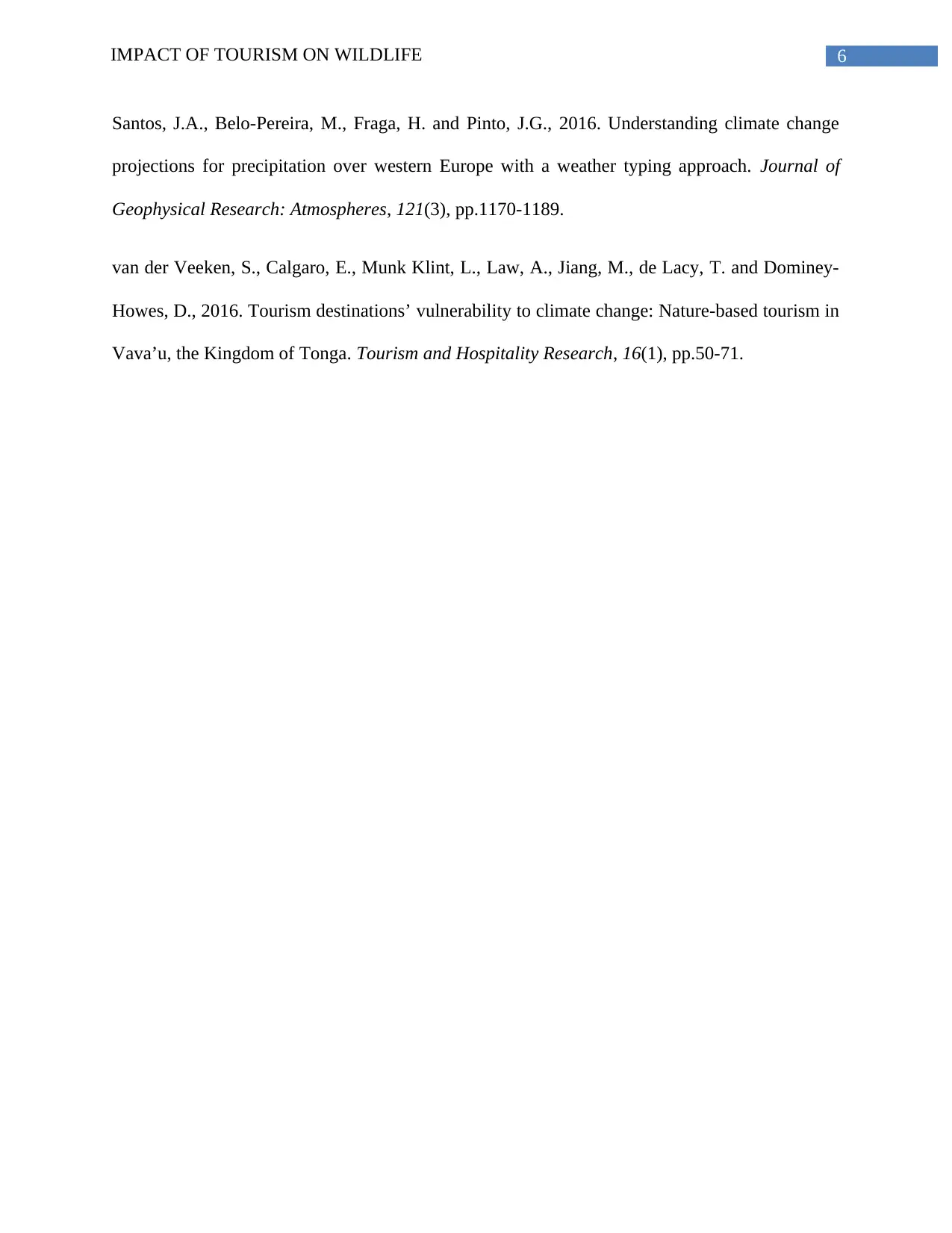
6IMPACT OF TOURISM ON WILDLIFE
Santos, J.A., Belo‐Pereira, M., Fraga, H. and Pinto, J.G., 2016. Understanding climate change
projections for precipitation over western Europe with a weather typing approach. Journal of
Geophysical Research: Atmospheres, 121(3), pp.1170-1189.
van der Veeken, S., Calgaro, E., Munk Klint, L., Law, A., Jiang, M., de Lacy, T. and Dominey-
Howes, D., 2016. Tourism destinations’ vulnerability to climate change: Nature-based tourism in
Vava’u, the Kingdom of Tonga. Tourism and Hospitality Research, 16(1), pp.50-71.
Santos, J.A., Belo‐Pereira, M., Fraga, H. and Pinto, J.G., 2016. Understanding climate change
projections for precipitation over western Europe with a weather typing approach. Journal of
Geophysical Research: Atmospheres, 121(3), pp.1170-1189.
van der Veeken, S., Calgaro, E., Munk Klint, L., Law, A., Jiang, M., de Lacy, T. and Dominey-
Howes, D., 2016. Tourism destinations’ vulnerability to climate change: Nature-based tourism in
Vava’u, the Kingdom of Tonga. Tourism and Hospitality Research, 16(1), pp.50-71.
1 out of 7
Related Documents
Your All-in-One AI-Powered Toolkit for Academic Success.
+13062052269
info@desklib.com
Available 24*7 on WhatsApp / Email
![[object Object]](/_next/static/media/star-bottom.7253800d.svg)
Unlock your academic potential
Copyright © 2020–2025 A2Z Services. All Rights Reserved. Developed and managed by ZUCOL.





